Abstract
Introduction
In today's society, the rapid and appropriate care of the dental emergency patients is much more important. So, a retrospective study on the characteristics of emergency dental injuries and diseases will be very meaningful.
Materials and Methods
This retrospective clinical study was carried by reviewing the radiographic films and emergency chart of 11,493 patients who had visited the emergency room of Hallym Sacred heart Hospital and were treated in the Department of Oral and Maxillofacial Surgery from January 2006 to December 2010.
Results
The male to female ratio was 1.9:1. The highest monthly incidence was observed in May (10.4%) and June (8.9%) and the peak age distribution was the first decade (56.0%), followed by the second decade (16.0%). Trauma was the most common cause in dental emergency patients, followed in order by toothache, odontogenic infection, temporomandibular joint (TMJ) disorder and oral hemorrhage. Soft tissue injury was most prevalent in the trauma group, followed by tooth injury and facial bone fractures. In the tooth injury group, tooth fracture (56.7%) showed the highest incidence followed in order by tooth subluxation (18.2%), tooth concussion (16.9%), tooth avulsion (11.5%) and alveolar bone fractures (3.7%). In the facial bone fracture group, mandibular fractures (81.8%) showed the highest incidence followed in order by maxilla fractures (15.7%), nasal bone fractures (9.0%), zygomaticomaxillary complex fractures (5.4%), orbital bone fractures (2.5%). In mandibular bone fractures, the most common location was the symphysis (70.1%), followed in order by the mandibular angle (33.0%), mandibular condyle (22.8%) and mandibular body (13.6%). In the infection group, a submandibular space abscess (46.2%) was most common followed in order by a buccal space abscess (17.4%), canine space abscess (16.9%) and submental space abscess (12.3%). TMJ dislocation (89.3%) showed the highest incidence in the TMJ disorder group, followed by TMJ derangement (10.7%). In the other group, a range of specific symptoms due to post operation complications, trigeminal neuralgia, chemical burns and foreign body aspiration were reported.
Go to : 
References
1. Huelke DF, Compton CP. Facial injuries in automobile crashes. J Oral Maxillofac Surg. 1983; 41:241–4.

2. Schultz RC. Facial injuries. 2nd ed.Chicago: Year book Medical Publishers;1977.
3. Topazian RG. Management of infections of the oral and maxillofacial regions. 1st ed.Philadelpia: WB Saunders;1981.
4. Roitt IM, Lehner T. Immunology of oral diseases. 2nd ed.London: Blackwell Scientific Publications;1994.
5. Falace DA. Emergency dental care. Baltimore: Williams & Wilkins;1995.
6. Galea H. An investigation of dental injuries treated in an acute care general hospital. J Am Dent Assoc. 1984; 109:434–8.
7. Looby JP. Needs and values of a hospital dental service. J Oral Surg (Chic). 1958; 16:471–3.
8. Henny FA. Dentistry's role in interdepartmental hospital relations. J Oral Surg (Chic). 1958; 16:285–90.
9. Malamed SF, Robbins KS. Medical emergencies in dental office. 4th ed.Washington DC: CV Mosby;1993.
10. McCarthy FM. Medical emergencies in dentistry. 3rd ed.London: Blackwell Scientific Publications;1983.
11. Conley JJ. Complications of head & neck surgery. 2nd ed.Philadelphia: WB Saunders;1979.
12. Alling CC, Davis BP Jr. Compound, comminuted, complex maxillofacial fractures. J Oral Surg. 1974; 32:415–25.
14. Laskin DM. Oral and maxillofacial surgery. 5th ed.Washington DC: CV Mosby;1975.
15. Korean Association of Oral & Maxillofacial Surgeons. Textbook of oral & maxillofacial surgery. 2nd ed.Seoul: Dental & Medical Publishing Co.;2005.
16. Keum K, Paeng JY, Choi BY, Choi JG, Oh SR, Lee J, et al. An clinical analysis on the dental emergency patients visiting the emergency room of Dental Hospital of Wonkwang University. J Korean Assoc Maxillofac Plast Reconstr Surg. 2009; 31:35–40.
17. Shim HG, Lee EW. A clinical study on nighttime emergency patients of the dental hospital Yonsei Medical Center. J Korean Assoc Oral Maxillofac Surg. 1985; 11:259–70.
18. Kim JR, Chung IK, Yang DK, Park BW. A clinical study on the emergency patients of oral and maxillofacial surgery during recent 5 years. J Korean Assoc Maxillofac Plast Reconstr Surg. 2001; 23:155–62.
19. Cho KS, Kim KY, Lee SH, Park HS, So KS, Cho YK, et al. A clinical study on oral & maxillofacial patients visiting Chongnam Univ-hospital emergency room. J Korean Maxillofac Plast Reconstr Surg. 1997; 19:435–46.
20. Lee DK, Min SK, Yang CY, Mun C, Kim JG. A clinical study on the dental emergency patients visiting Wonkwang Univ-hospital emergency room. J Korean Assoc Maxillofac Plast Reconstr Surg. 2002; 24:31–9.
21. Baik JS, Yoon KH, Park KS, Cheung JK, Shin JM, Choi MH, et al. A clinical study on the emergency patients of oral and naxillofacial surgery visiting Sang-gye Paik Hospital emergency room. J Korean Assoc Maxillofac Plast Reconstr Surg. 2008; 30:561–6.
22. Moon WK, Jung YS, Lee EW, Kwon HK, Yoo JH. The characteristics on the dental emergency patients of wonju christian hospital for last 10 years. J Korean Assoc Oral Maxillofac Surg. 2004; 30:34–42.
23. Turvey TA. Midfacial fractures: a retrospective analysis of 593 cases. J Oral Surg. 1977; 35:887–91.
24. Yoon OK. Clinico-reontgenographic studies on fracture lines of the maxillofacial bones. J Korean Assoc Oral Maxillofac Surg. 1976; 14:179–184.
25. Lee EW, Park HS. A clinical study on facial bone fractures of Koreans. J Korean Assoc Oral Maxillofac Surg. 1983; 9:99–114.
26. Nakamura T, Gross CW. Facial fractures. Analysis of five years of experience. Arch Otolaryngol. 1973; 97:288–90.

27. Seo CH. A clinical study of facial bone fracture in 238 cases. J Korean dental assoc. 1976; 14:179–84.
28. Park JH, Heo NO, Jeon IS, Shin MS, Rho YS, Yoon KH. A clinical and statistical study of mandibular fractures. J Korean Maxillofac Plast Reconstr Surg. 1994; 16:281–9.
29. Small EW. Survey of maxillofacial fractures. J Oral Surg. 1976; 34:27–8.
30. Joo HH, Weon DW, Lee SH, Kim IH. A clinic-statistical analysis on the fascial space infections of oral and maxillofacial region. J Korean Assoc Oral Maxillofac Surg. 2000; 26:490–6.
31. Kelly DE, Harrigan WF. A survey of facial fractures: Bellevue Hospital, 1948–1974. J Oral Surg. 1975; 33:146–9.
32. Choi SR, Lee HC. Mandibular fractures in Korean. Taehan Chikkwa Uisa Hyophoe Chi. 1971; 9:829–35.
33. Dingman RO, Natvig P. Surgery of facial fracture. 2nd ed.Philadelphia: WB Saunders;1973.
34. Kim MS, Nam OH, Kim SG, Cho SI. A clinicostatistical analysis of oral and maxillofacial infected patients. J Korean Assoc Maxillofac Plast Reconstr Surg. 2002; 24:317–24.
Go to : 
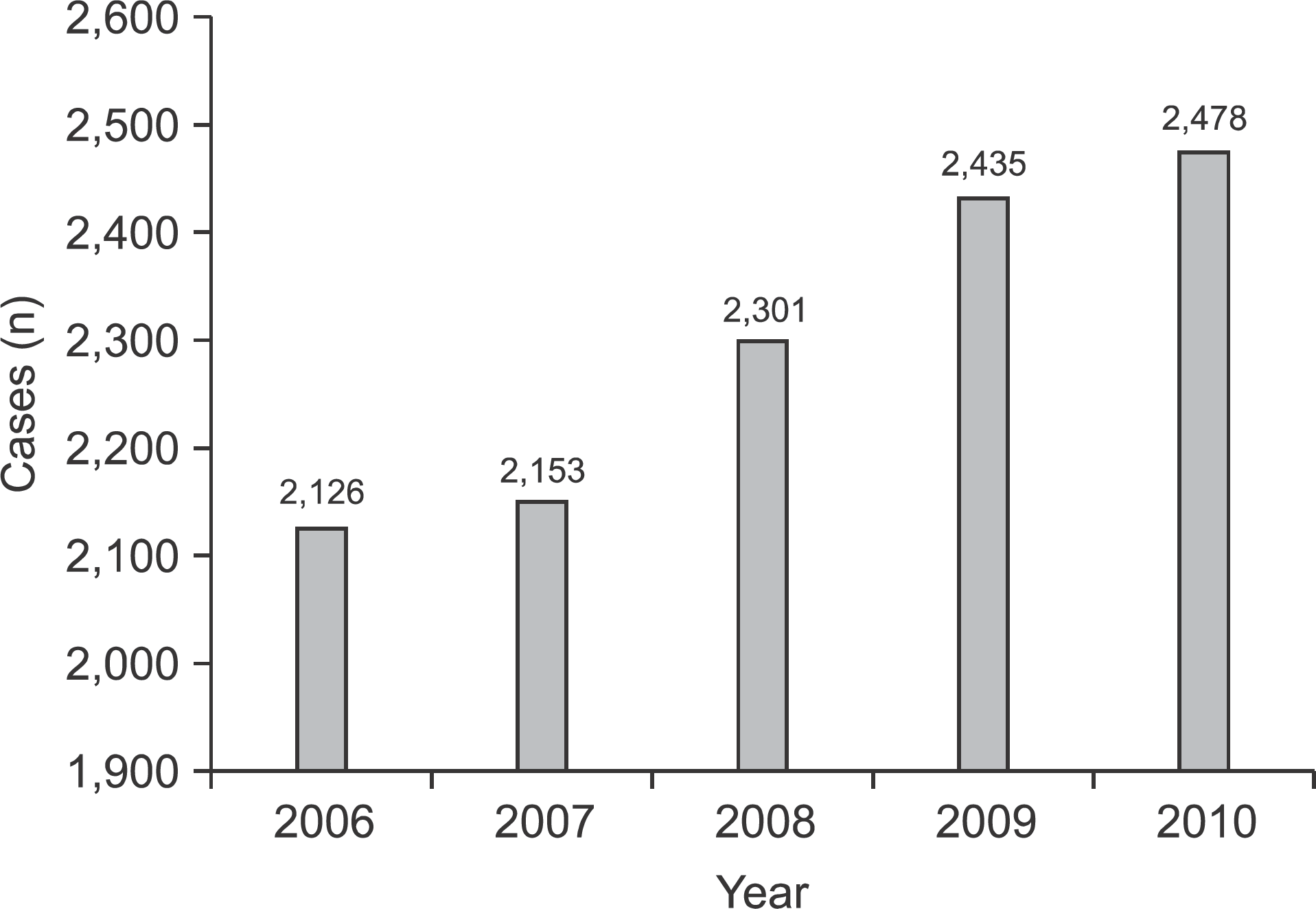 | Fig. 1.Yearly distribution of total patients. Chang-Su Jang et al: A clinical study on the dental emergency patients visiting an University Hospital emergency room. J Korean Assoc Oral Maxillofac Surg 2011
|
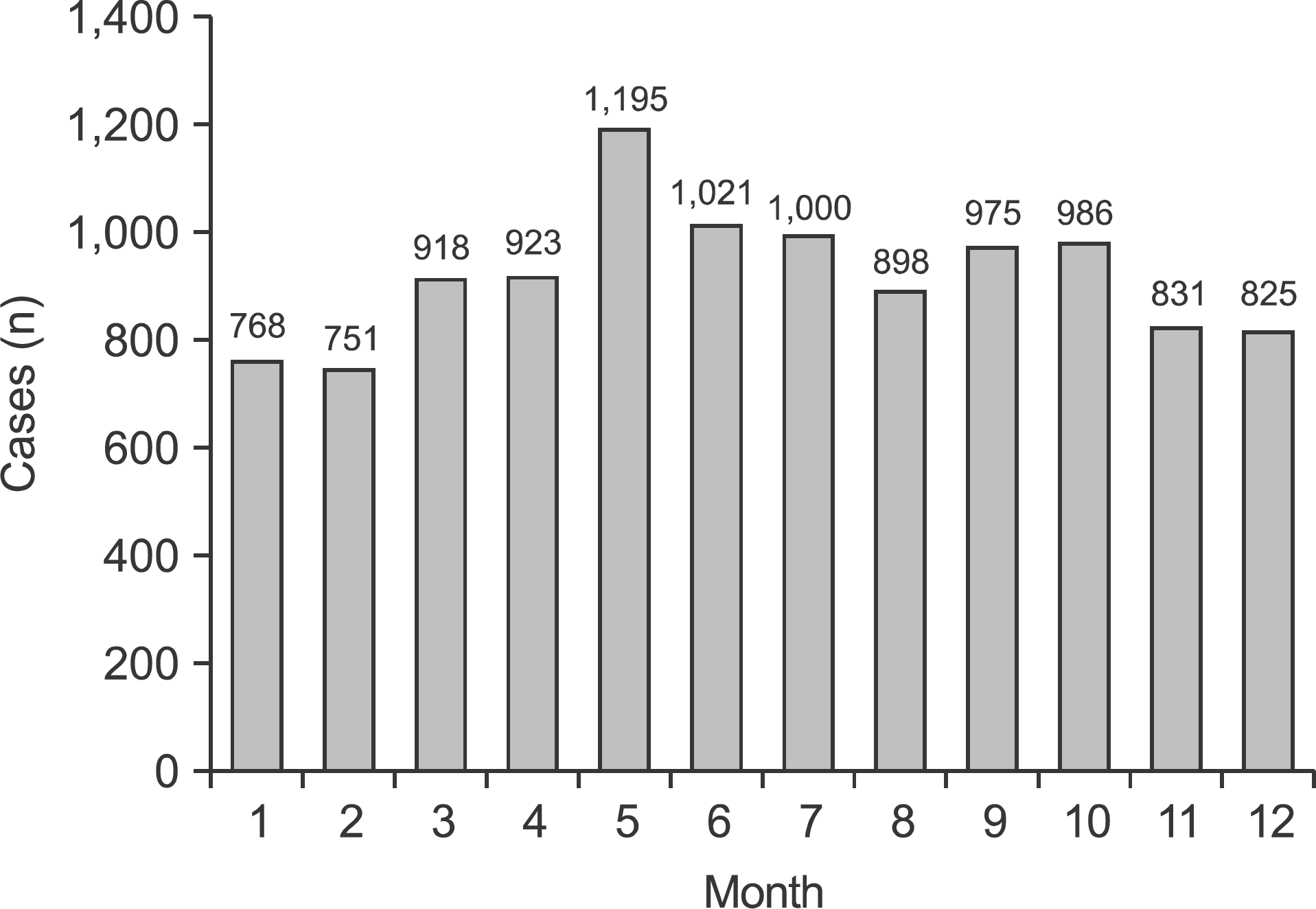 | Fig. 2.Monthly distribution of total patients. Chang-Su Jang et al: A clinical study on the dental emergency patients visiting an University Hospital emergency room. J Korean Assoc Oral Maxillofac Surg 2011
|
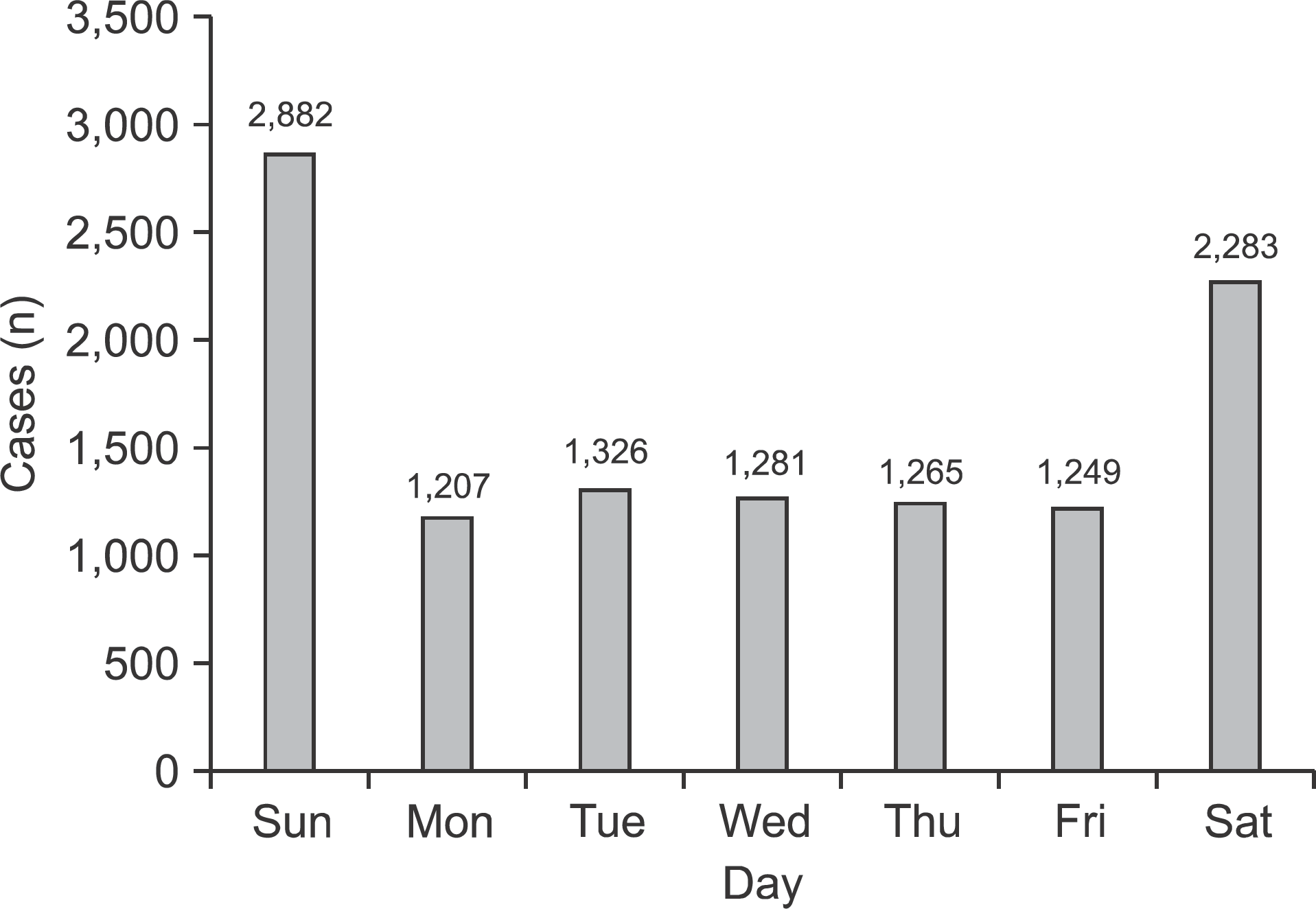 | Fig. 3.Daily distribution of total patients. Chang-Su Jang et al: A clinical study on the dental emergency patients visiting an University Hospital emergency room. J Korean Assoc Oral Maxillofac Surg 2011
|
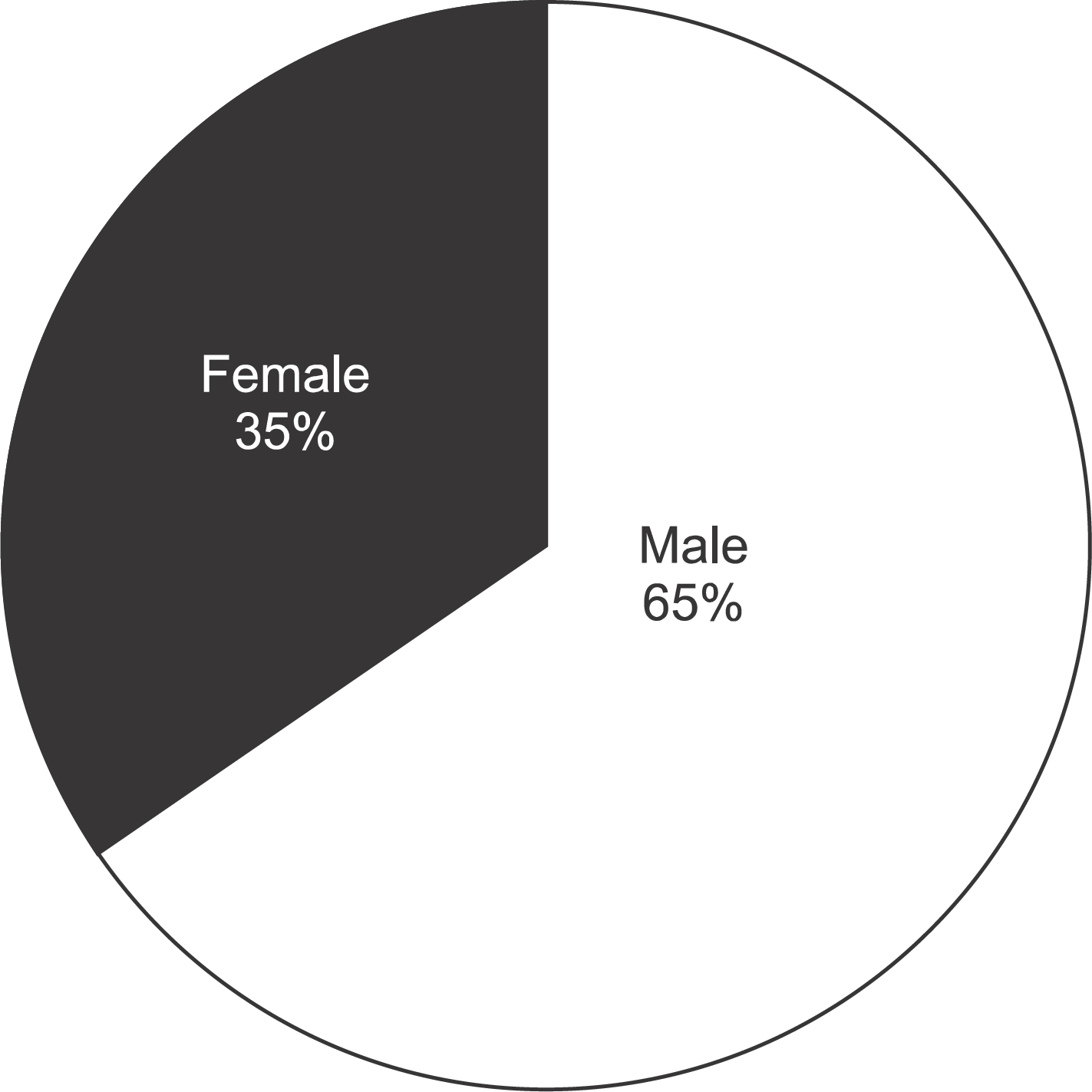 | Fig. 4.Distribution according to gender. Chang-Su Jang et al: A clinical study on the dental emergency patients visiting an University Hospital emergency room. J Korean Assoc Oral Maxillofac Surg 2011
|
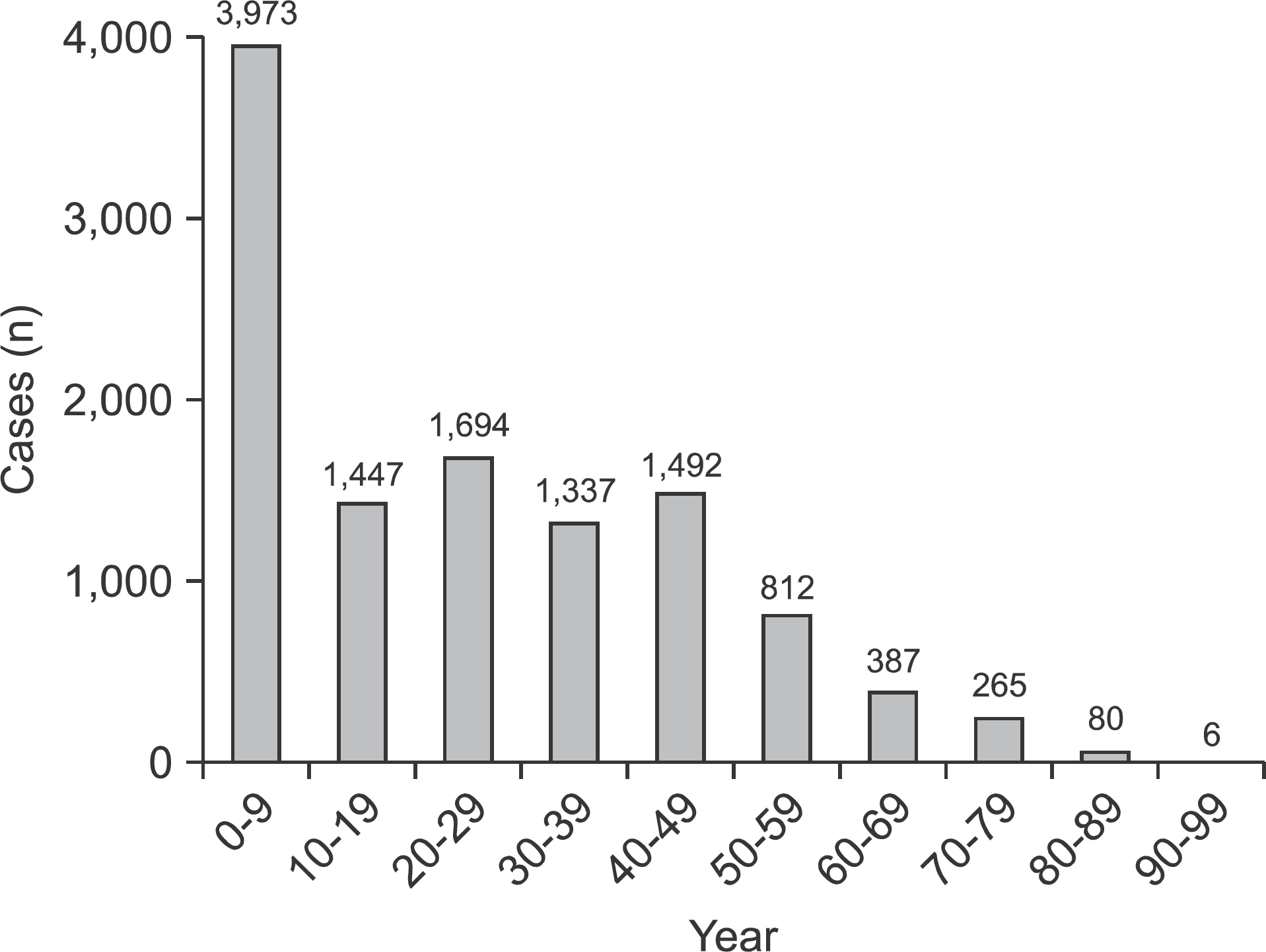 | Fig. 5.Distribution according to age. Chang-Su Jang et al: A clinical study on the dental emergency patients visiting an University Hospital emergency room. J Korean Assoc Oral Maxillofac Surg 2011
|
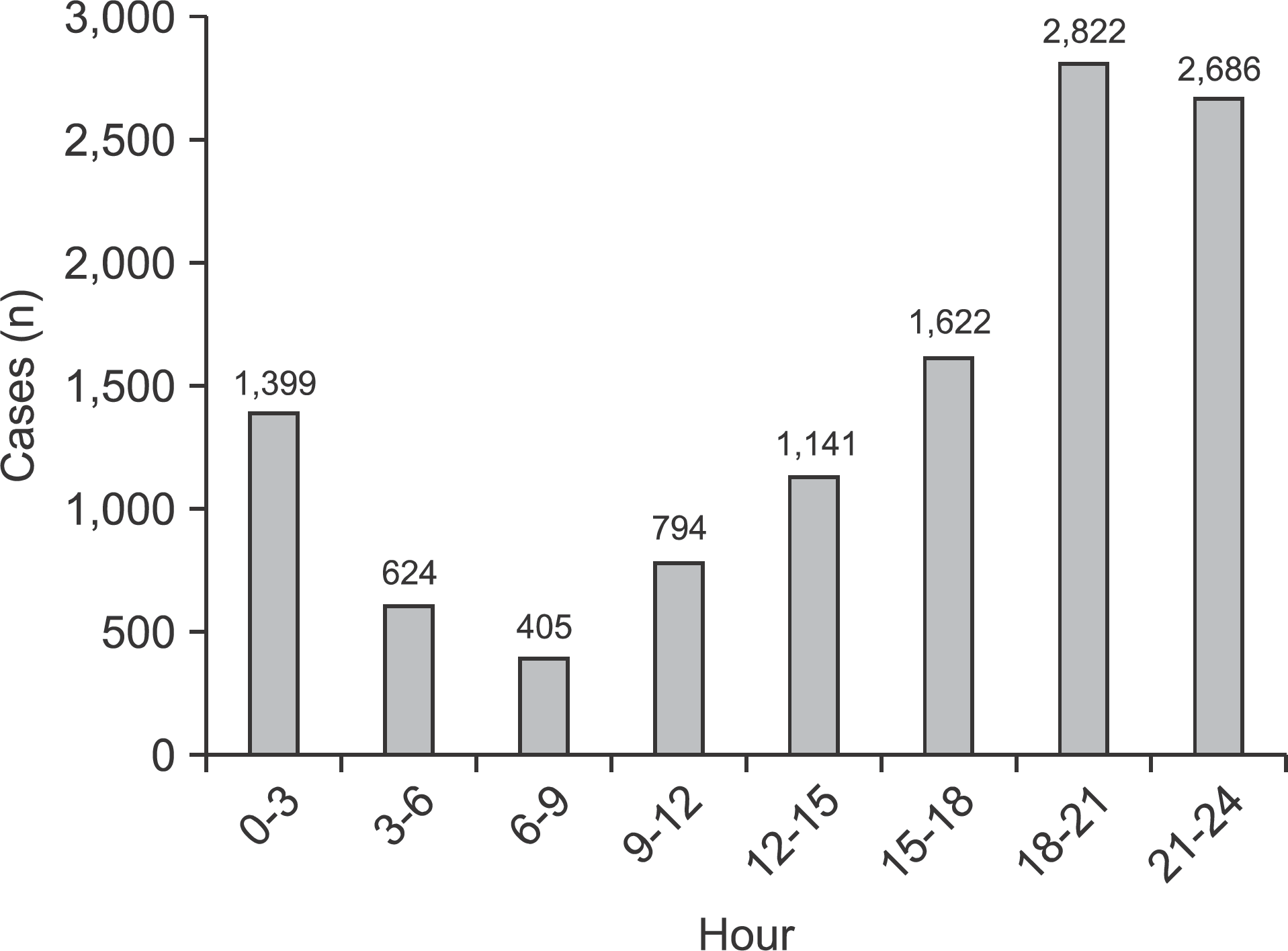 | Fig. 6.Distribution according to visiting time. Chang-Su Jang et al: A clinical study on the dental emergency patients visiting an University Hospital emergency room. J Korean Assoc Oral Maxillofac Surg 2011
|
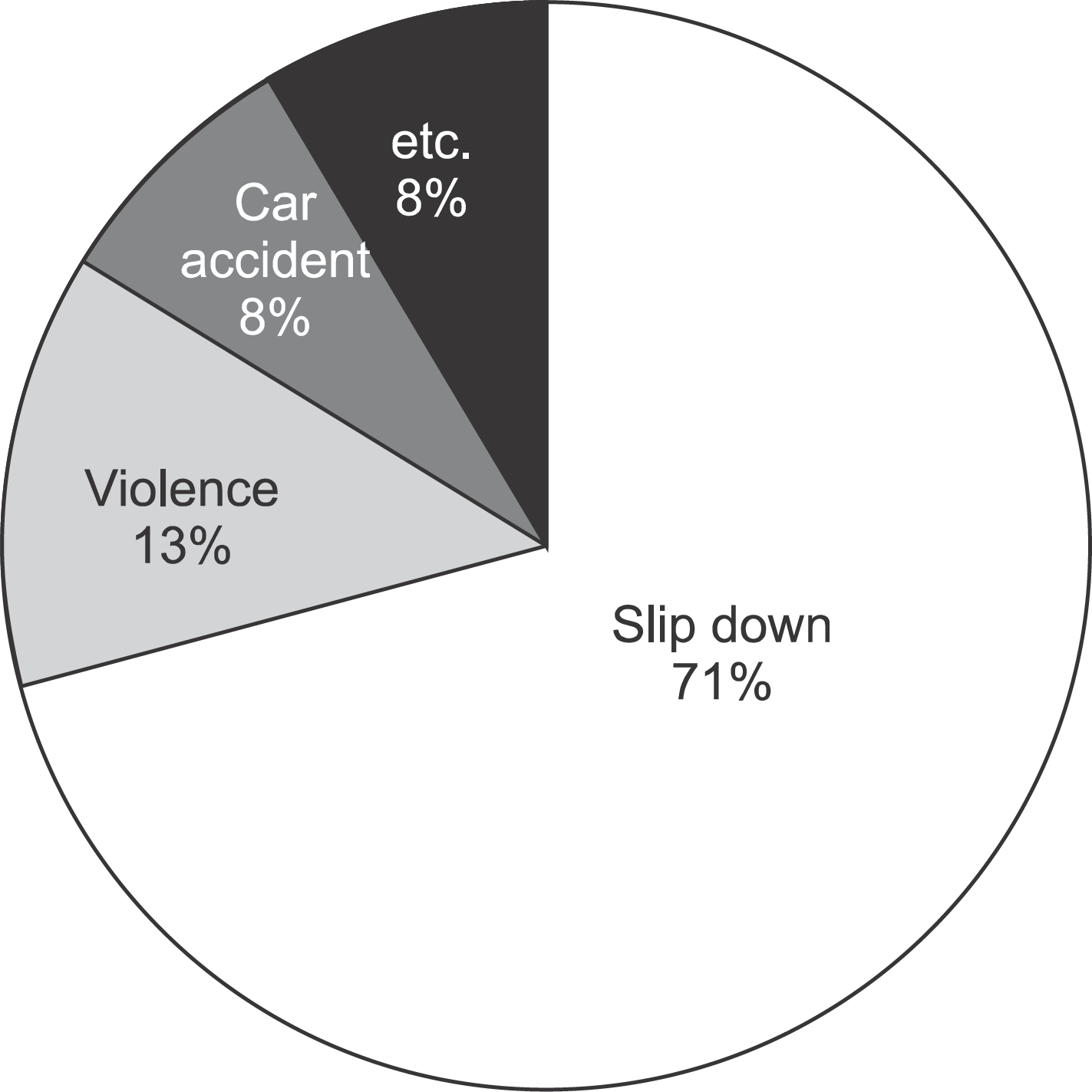 | Fig. 7.Casual distribution of traumatic injury. Chang-Su Jang et al: A clinical study on the dental emergency patients visiting an University Hospital emergency room. J Korean Assoc Oral Maxillofac Surg 2011
|
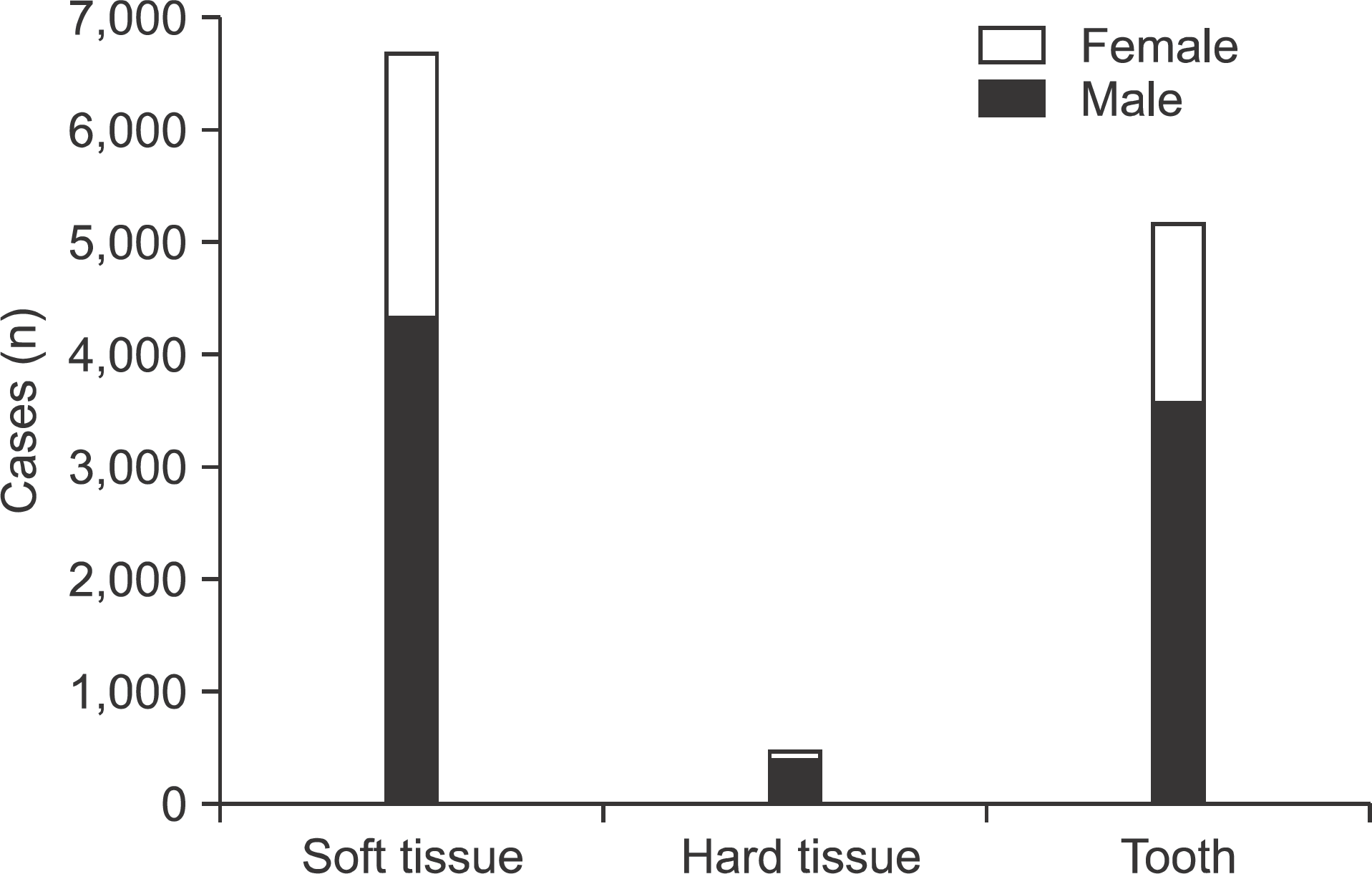 | Fig. 8.Distribution according to traumatic injury site. Chang-Su Jang et al: A clinical study on the dental emergency patients visiting an University Hospital emergency room. J Korean Assoc Oral Maxillofac Surg 2011
|
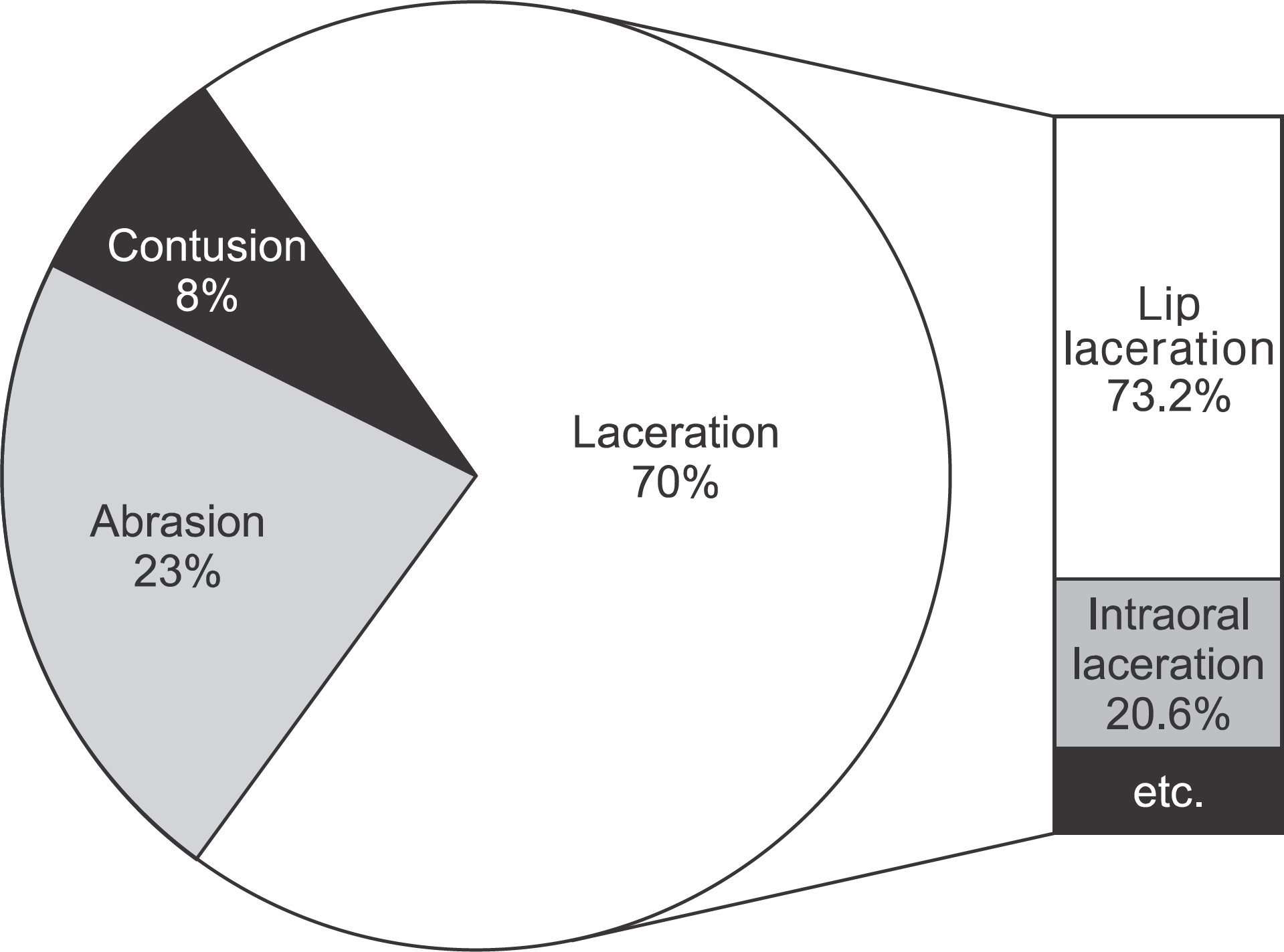 | Fig. 9.Distribution according to the type of soft tissue injury. Chang-Su Jang et al: A clinical study on the dental emergency patients visiting an University Hospital emergency room. J Korean Assoc Oral Maxillofac Surg 2011
|
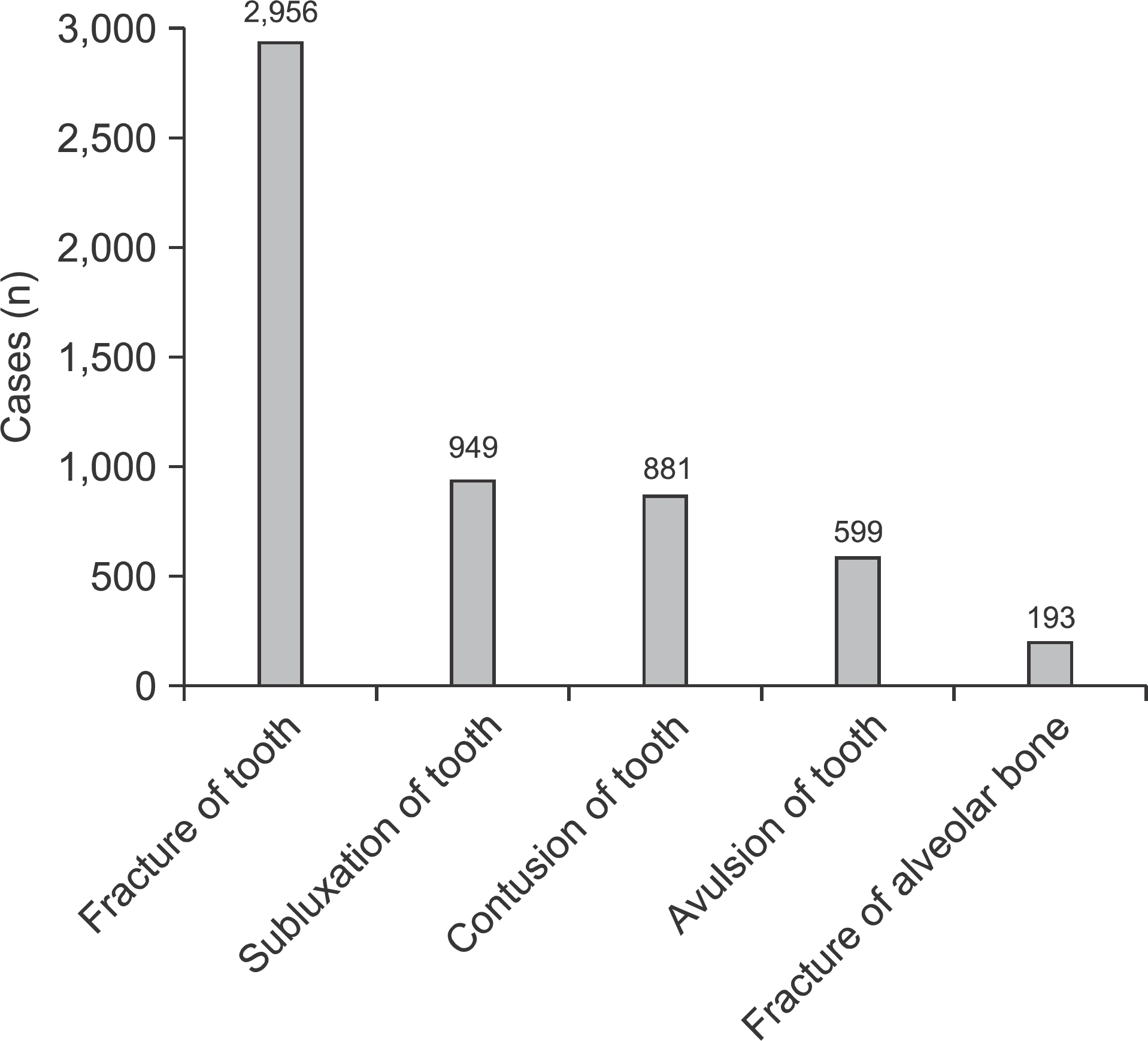 | Fig. 10.Distribution of tooth injured type. Chang-Su Jang et al: A clinical study on the dental emergency patients visiting an University Hospital emergency room. J Korean Assoc Oral Maxillofac Surg 2011
|
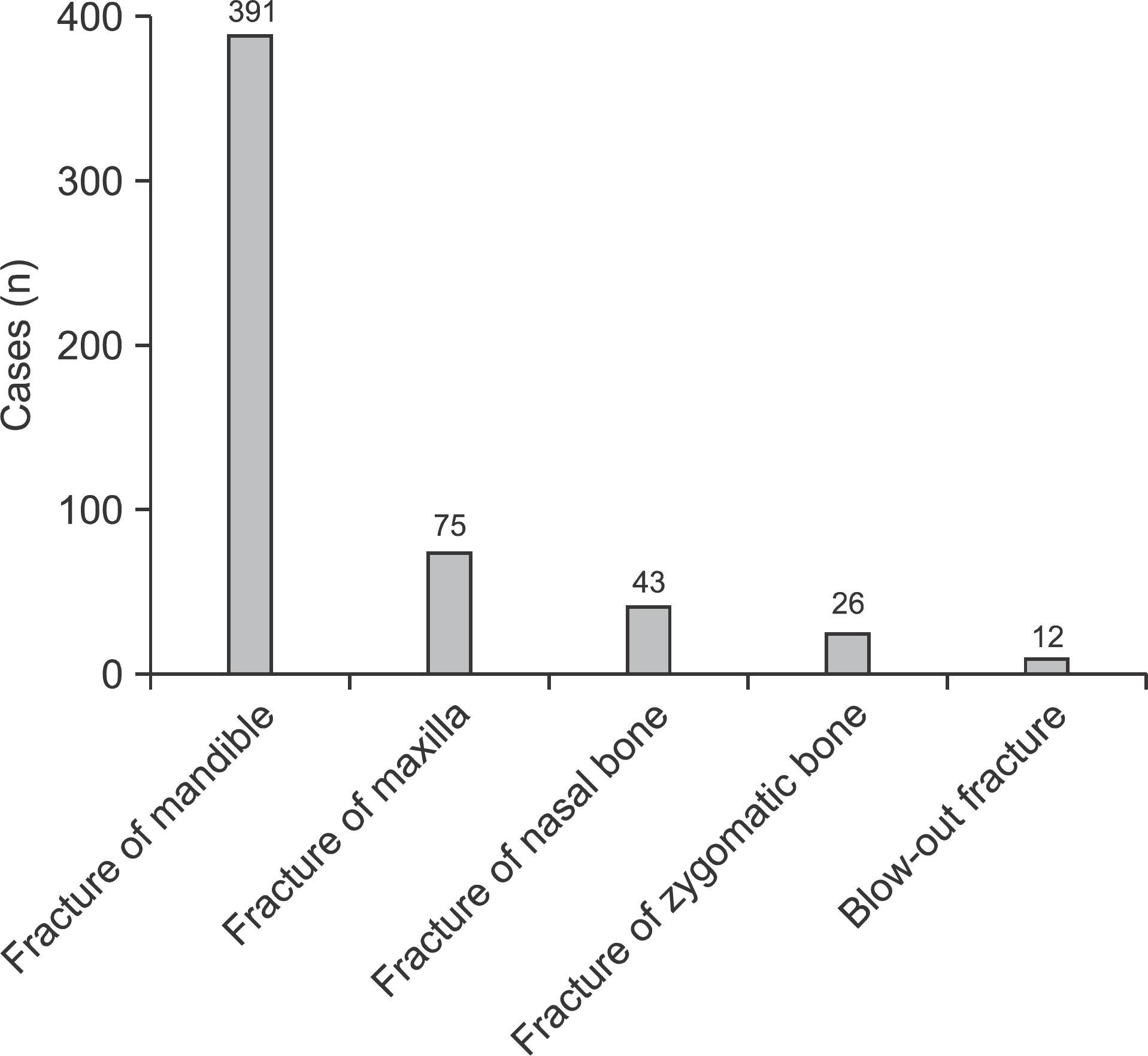 | Fig. 11.Distribution of facial bone fracture site. Chang-Su Jang et al: A clinical study on the dental emergency patients visiting an University Hospital emergency room. J Korean Assoc Oral Maxillofac Surg 2011
|
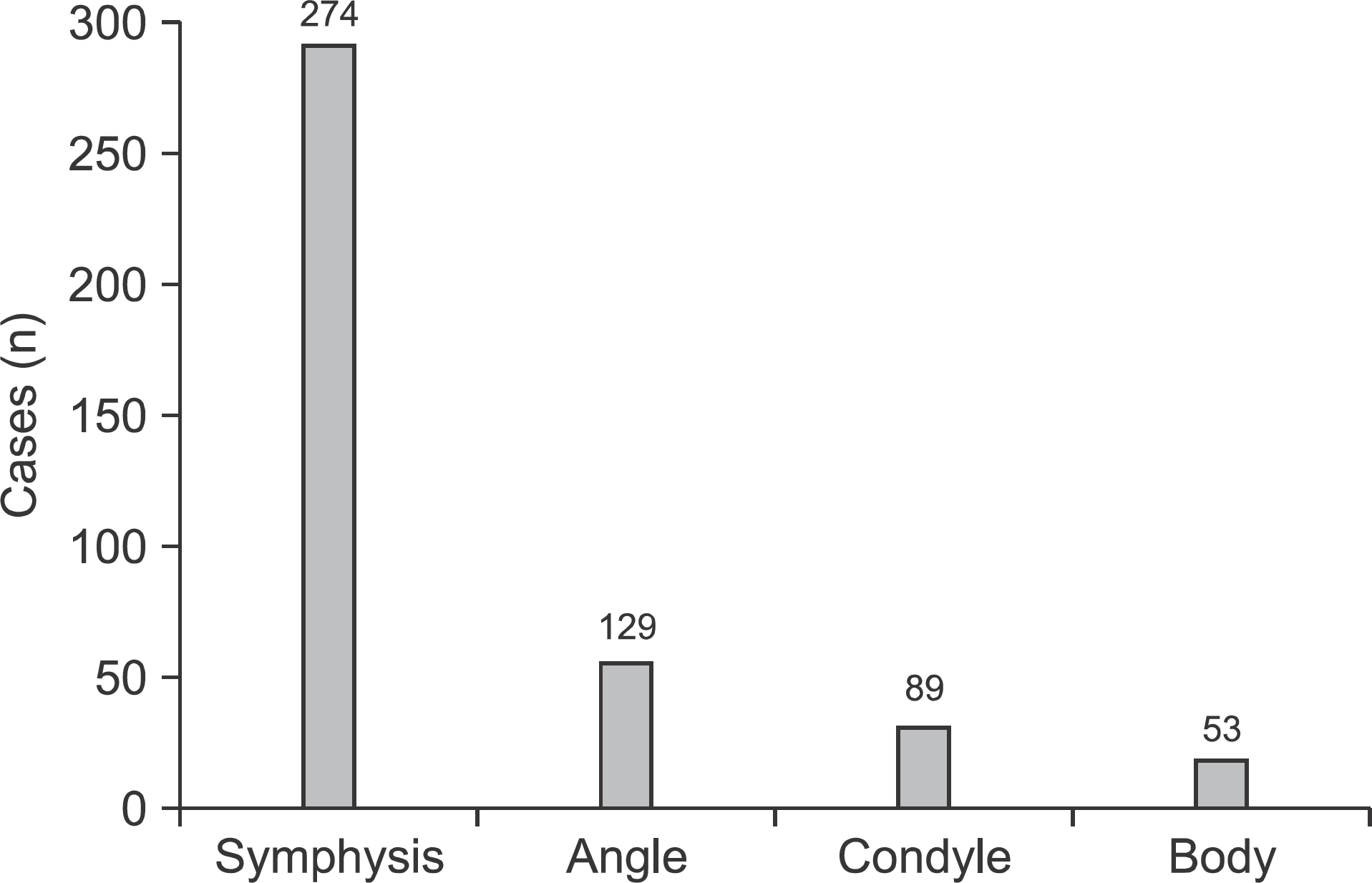 | Fig. 12.Distribution of mandibular fracture. Chang-Su Jang et al: A clinical study on the dental emergency patients visiting an University Hospital emergency room. J Korean Assoc Oral Maxillofac Surg 2011
|




 PDF
PDF ePub
ePub Citation
Citation Print
Print


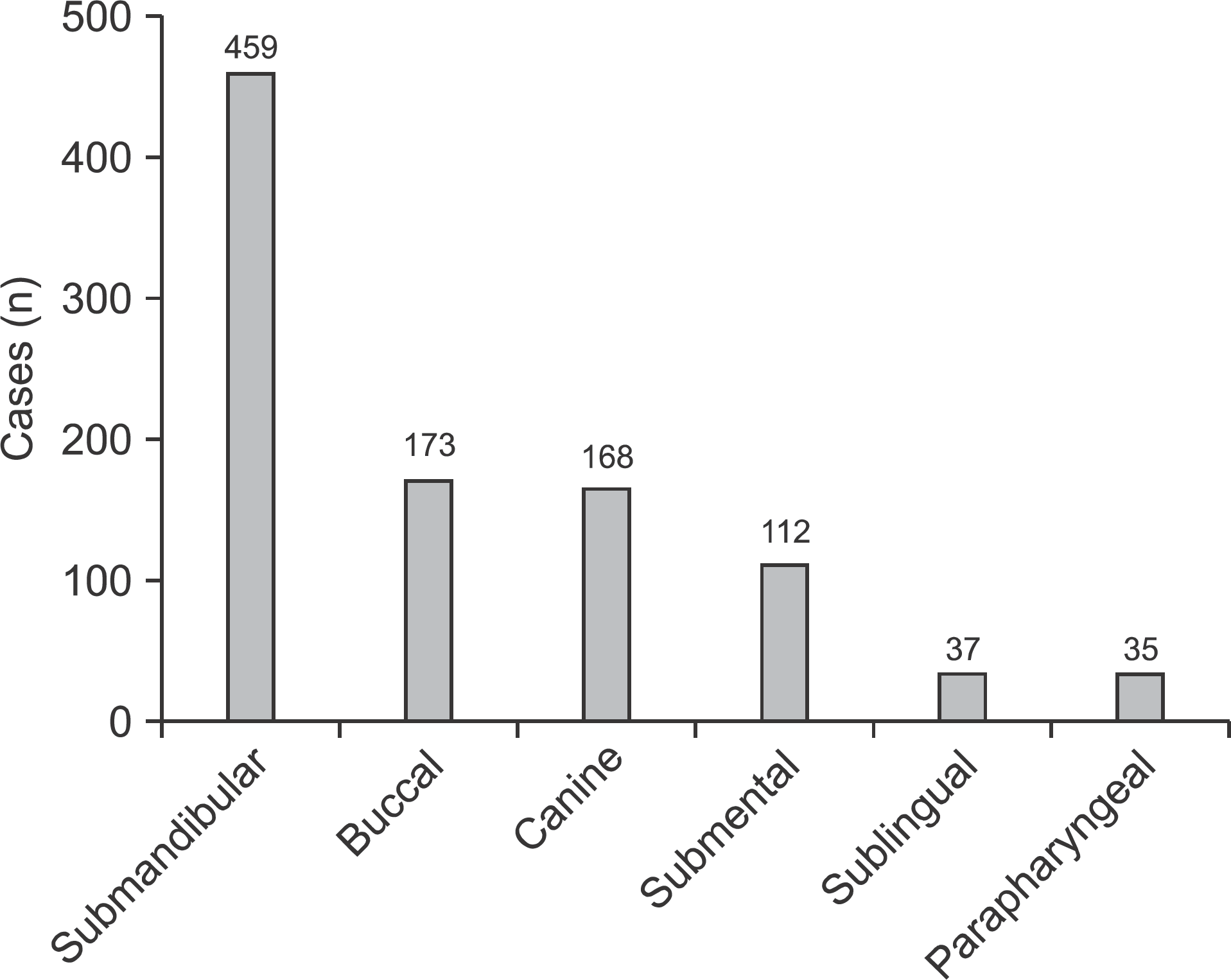
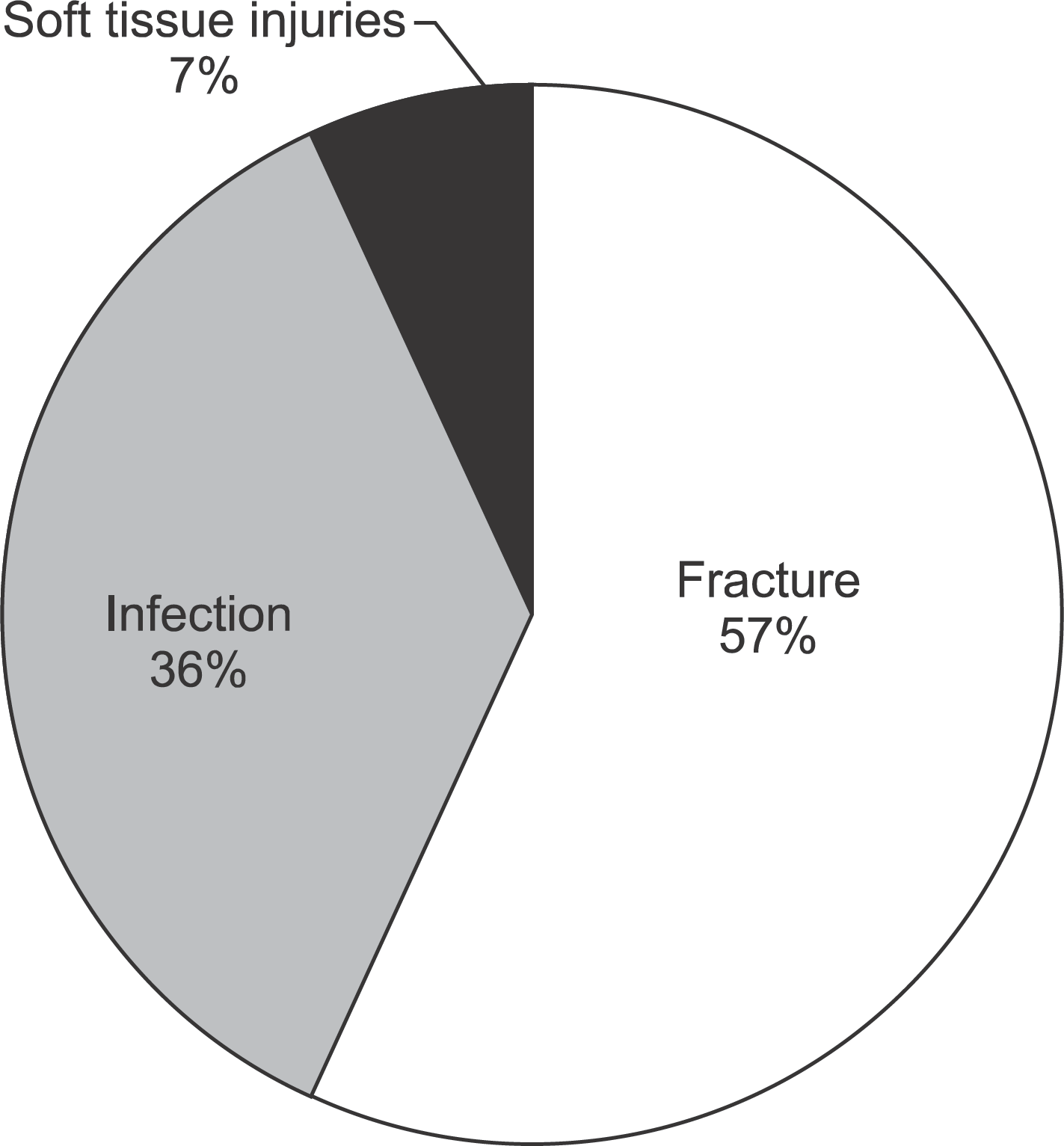
 XML Download
XML Download